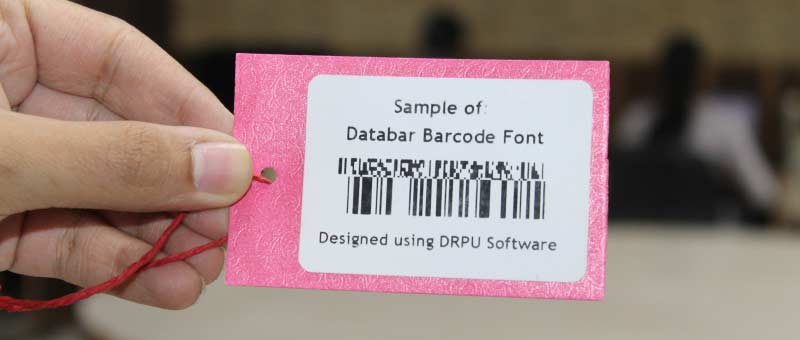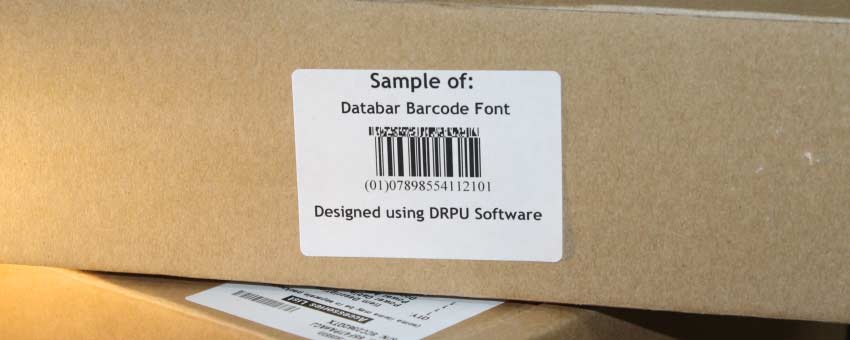Introduction of Databar Barcode
There are several types of Databar barcodes, including Databar-14, Databar Limited, Databar Expanded, and Databar Stacked. Each type has a different set of specifications and data capacity, and is designed for different applications.

Also known as Databar Omnidirectional, is a linear barcode that can encode up to 14 digits of numeric data, or 13 digits of alphanumeric data. It is often used to encode GTIN-14 numbers, which are used to identify individual items or products within a larger case or shipping container.
Also known as Databar-14 Stacked Omnidirectional, is a stacked barcode that can encode up to 74 digits of numeric data, or 41 digits of alphanumeric data. It is designed for small items that require more data than can be encoded in a linear barcode, but do not have the space for a larger barcode.
Also known as Databar-14 Stacked, is a stacked barcode that can encode up to 174 digits of numeric data, or 93 digits of alphanumeric data. It is designed for small items that require more data than can be encoded in a linear barcode, and used to encode additional information, such as expiration dates and lot numbers.
Also known as Databar Expanded Stacked, is a stacked barcode that can encode up to 74 digits of numeric data, or 41 digits of alphanumeric data. It is designed for those applications where a smaller size of barcode is required, but more data is needed than can be encoded in a linear barcode font.
-
The structure of a Databar barcode consists of a series of bars and spaces, with each bar and space representing either a 0 or a 1. The data is encoded in a series of binary patterns, which are then translated into bars and spaces using a specific algorithm. The barcode also includes a start and stop character, which indicates the beginning and end of the barcode.
-
Databar barcodes can be scanned using a variety of devices, including handheld scanners, mobile phones, and fixed scanners. The barcode is read by scanning the bars and spaces with a laser or camera, which then decodes the binary pattern and translates it into the original data.
-
One of the main advantages of Databar barcodes is their ability to encode more data in a smaller space than traditional linear barcodes. This makes them ideal for use on small items, such as produce and pharmaceuticals, where space is limited. They also provide greater accuracy and reliability than traditional barcodes, as they include error correction codes to ensure that the data is read correctly.
-
However, one limitation of Databar barcodes is that they are not as widely used as traditional linear barcodes, which can make it more difficult to find scanners and other equipment that can read them. They also require specialized software to generate and read, which can add to the cost of implementation.
-
In terms of cost, the implementation of Databar barcodes will vary depending on the specific application and the equipment needed. The cost of software and hardware may be higher than for traditional barcodes, but this may be offset by the benefits of increased data capacity and accuracy.
Download and Install Barcode Software
Structure of a Databar Barcode
Databar is a type of barcode also known as Reduced Space Symbology (RSS) barcode. It is a relatively new type of barcode, introduced in 2001 by the Uniform Code Council (UCC). Databar barcodes are capable of storing large amounts of data in a small space and are mainly used in the retail industry for tracking products. The structure of a Databar barcode is a series of bars and spaces of varying widths, arranged in a specific pattern that represents the encoded data.
-
➽ Databar barcodes come in two main versions: Databar Expanded and Databar Limited. The Databar Expanded version is capable of encoding up to 74 characters of data, while the Databar Limited version can encode up to 14 characters of data. Both versions of the Databar barcode are similar in structure, with the main difference being the amount of data that can be encoded.
-
➽ The Databar barcode is a 2D barcode, which means that it can store data both horizontally and vertically. The barcode consists of a series of stacked rows, with each row representing a different part of the encoded data. The barcode is read from left to right, with each row being scanned in sequence.
-
➽ The Databar barcode uses a series of bars and spaces of varying widths to represent the encoded data. The bars and spaces are arranged in a specific pattern, with each pattern representing a specific character or combination of characters. The width of each bar and space is carefully controlled to ensure that the barcode can be accurately read by a barcode scanner.
-
➽ In addition to the standard bars and spaces, the Databar barcode also includes a number of special characters. These characters are used to indicate the start and end of the barcode, as well as to separate different parts of the encoded data.
Conclusion: The structure of a Databar barcode is highly complex and carefully controlled. The barcode is designed to be easy to read by barcode scanners, while also being capable of storing large amounts of data in a small space.
Applications of Databar Barcode
Databar, also known as Reduced Space Symbology (RSS), is a family of barcodes designed for use in retail and grocery stores. Databar barcodes are used to encode product information, including the product's Global Trade Item Number (GTIN), serial number, and expiration date. They are also used for coupon and loyalty programs, as well as for tracking inventory.

-
01 Databar
Omnidirectional
This type of Databar barcode is used for smaller items, such as individual items or small packages. It is a 14-digit barcode that can be read in any direction.
-
02 Databar Truncated
This barcode is similar to the Omnidirectional barcode, but it is truncated to make it smaller. It is used for items that have limited space for barcodes.
-
03 Databar Limited
This barcode is used for items that have even less space for barcodes than those that use the Truncated barcode. It is a 10-digit barcode.
-
04 Databar Stacked
This type of Databar barcode is used for applications that require more data than can be encoded in a single row. It can encode up to 74 digits.
-
05 Databar Expanded
This barcode is used for larger items, such as cases or pallets of products. It can encode up to 74 digits.
-
06 Databar Stacked
Omnidirectional
This barcode is similar to the Stacked barcode, but it can be read in any direction. It can also encode up to 74 digits.
-
07 Databar Expanded
Stacked
This barcode is similar to the Expanded barcode, but it can encode more data by stacking multiple rows. It can encode up to 200 digits.
Databar barcodes are widely used in the retail industry, particularly in grocery stores. They are used to encode product information, such as the product's GTIN, which is used to identify the product and its manufacturer. Databar barcodes are also used for tracking inventory, as well as for coupon and loyalty programs. They are a compact and efficient way to encode large amounts of data in a small space, making them ideal for use on small products or in situations where space is limited.
One of the key advantages of Databar barcodes is that they can encode more data than traditional UPC barcodes. This allows them to be used for more than just product identification, and makes them a useful tool for tracking inventory and managing retail operations. Additionally, Databar barcodes are more flexible than traditional UPC barcodes, as they can be resized and truncated to fit the available space on a product.
Conclusion:Overall, the applications of Databar barcodes are widespread in the retail industry, and they play an important role in tracking inventory, managing retail operations, and providing customers with valuable information about the products they purchase.
Difference Between Databar Barcode and other Barcode Types
Databar, also known as RSS (Reduced Space Symbology), is a family of linear barcode symbols developed by GS1. Databar is a more compact version of other GS1 barcodes like EAN/UPC and Code 128, designed to fit on small retail items or in situations where a smaller barcode is needed. Databar can encode a variety of data types, including GTIN, serial numbers, and expiration dates. In this section, we will discuss how Databar is different from other barcode types.
-
Size:
One of the most significant differences between Databar and other barcode types is its size. Databar is a more compact barcode that can fit on smaller items, making it ideal for use in retail environments where space is limited. Unlike other barcode types that require a certain amount of white space around the barcode to ensure readability, Databar can be printed in a very small size without sacrificing readability.
-
Data Encoding:
Databar is designed to encode specific types of data, including GTIN, serial numbers, and expiration dates. Other barcode types like EAN/UPC and Code 128 can also encode this data, but they are not optimized for it like Databar. This means that Databar is more efficient at encoding this type of data, resulting in a more compact barcode.
-
Scanning:
Databar uses a different scanning technology than other barcode types. Databar barcodes are typically scanned using imaging scanners, which capture an image of the barcode and then decode it. Other barcode types like EAN/UPC and Code 128 are usually scanned using laser scanners, which use a beam of light to read the barcode.
-
Industry Use:
Databar is primarily used in the retail industry for small items like produce, meat, and baked goods. Other barcode types like EAN/UPC and Code 128 are more commonly used in other industries like manufacturing, shipping, and logistics.
-
Capacity:
Databar has a limited data capacity compared to other barcode types like Code 128. This is because it is designed to be a more compact barcode and is optimized for encoding specific types of data. While Databar can encode a significant amount of data, it is not suitable for more complex data types like alphanumeric data.
Summary: Databar is a smaller, more compact barcode designed for use in the retail industry. It is optimized for encoding specific types of data and is typically scanned using imaging scanners. While Databar has a limited data capacity compared to other barcode types, it is more efficient at encoding certain types of data, resulting in a more compact barcode.